For locals who lived through both Hurricanes Wilma and Irma — two of the most destructive storms in the Florida Keys in recent memory — the differences are stark. Wilma, in 2005, was mostly a surge event. It was a confusing moment — the Keys were rocked by flooding while experiencing very little wind or rain.
Irma, on the other hand, was the classic hurricane nightmare. It seemed to zero in on the Keys days in advance and build in power and strength until it unleashed on the Lower Keys with high winds and damaging floods in 2017.
They have two similarities, though. One, both had big impacts on the island chain. Two, both had already passed over land within a day of landing in the Keys.
“Wilma spent some time over the Yucatan and Irma went over the north central coast of Cuba,” said Jon Rizzo, the warning meteorologist for the National Weather Service in Key West. “Had that not occurred in either storm, we would have likely been facing much stronger impacts from both of them.”
WILMA

In 2005, Keys residents were coming off not one, but two, exhausting hurricane seasons with a total of 36 named storms since June 2004. Evacuations had been called multiple times and residents had duly packed up their precious people, pets and belongings and found their way to the mainland. By Oct. 24, when Wilma looked to sweep west of Key West, locals stayed put — perhaps due to financial costs incurred by the past evacuations or because they deemed the storm’s track was sufficiently far away to be safe. At the time, officials estimated only 10% of the population evacuated. It was a costly decision for some in one respect — many cars “drowned.”
According to the Miami Herald, 20,000 cars were damaged just in the Keys. State Farm told an industry publication that it received 35,409 claims in South Florida. More than one car caught fire as the waters receded and the engine’s electrical system shorted out. Thankfully, most residents received immediate insurance checks to cover their cars.
Hurricane Wilma formed near Jamaica, moved northwest to the Yucatan peninsula, popped back into the Gulf of Mexico and made a beeline for the Florida mainland — or the “backside of the Keys.” The storm’s track was an important factor in the flooding the Keys experienced.
Wilma produced two storm surges as it swept past the Keys to the west. The first, on the oceanside, was small, the second, from the Gulf of Mexico, was devastating. The storm surges started in Key West on the gulfside and worked their way up to about Islamorada. In many places, the storm surge moved from north to south across the island. There were many photographs of water pouring off the seawall, like a waterfall, back into oceanside canals.
During the second surge, the water rose very quickly. Weather officials estimated it took about 15 minutes for waters to reach 3 feet deep in parts of Key West at 9 a.m.
Mel Fisher Maritime Museum archaeologist Corey Malcom was in New York City when Wilma hit and didn’t get back to his home in Key West until days after.
“Just walking into the house everything looked normal, nothing was out of place at first glance. But then you opened a cupboard in the kitchen and every pot and pan was filled with flood water. The beds were soaked. The furniture was soaked,” Malcom said.
“And it was the whole neighborhood. The contents of everyone’s home was out on the street … it was phenomenal, the loss. Even the old Conchs in my neighborhood had never seen anything like that. What a crazy and sad ordeal that was,” he said. “We’re always so scared of the wind, but the flooding is our big enemy in the Keys.”
On Stock Island, waters were reportedly 3 feet over mean sea level (MSL; halfway between high and low tides) and as high as 5 to 8 feet above MSL in the Lower Keys. By 11 a.m., Marathon and the Middle Keys were flooding, again about 5 to 8 feet above MSL. By about 3 p.m. the Upper Keys were flooding in some places with 4.5 to 5 feet of water.
“We were feeling calm because the winds had died down when we got a phone call from our neighbor who told us water was pouring into our neighborhood,” said Marianne Benvenuti, who lives on the gulfside of Marathon. “We went outside and the water was up to our waist. The cardboard boxes stored under our house — filled with papers — were floating down our little path into the street.”
After Hurricane Wilma passed, many homeowners faced extensive renovation — tearing up tile floors, and cutting out half the home’s drywall, the bottom half ruined by flooding. Oh, and buying a new car.
The total insurance claim payments totaled $208,810,412 for Hurricane Wilma in Monroe County, according to the state Office of Insurance Regulation.
IRMA

2017’s Hurricane Irma formed off the coast of Africa and made landfall four times in the Caribbean before coming ashore in the Keys in early September. The big beast just kept coming, seemingly aiming for the dead center of the 7 Mile Bridge.
“Hurricane Irma went straight through the Keys with much stronger winds. There was a tremendous oceanside surge,” Rizzo said.
When Irma moved off Cuba and over the warm waters of the Florida Straits, the hurricane re-intensified once again. Data from the Air Force Hurricane Hunters indicate that Irma became a Category 4 hurricane when it was centered about 60 miles south-southeast of Key West. The eye passed over Cudjoe Key and out into the Gulf of Mexico, aimed for Marco Island.
According to the weather service, storm surge and normal tides piled water onshore 5 to 8 feet deep from Cudjoe Key east to Big Pine Key and Bahia Honda Key. A high-water mark of 4.11 feet above ground level was surveyed in Key Largo, and a mark of 3.72 feet above ground level was recorded in Marathon.
Bob Keyt rode out the storm on his boat docked in the Middle Keys and said he experienced whiteout conditions from the blinding wind and rain. “Even the water in this small basin looked like whipped cream. It was perfectly white,” he said, adding that the storm surge topped the dock pilings by about 3 feet.
But if Hurricane Wilma was a water nymph, Hurricane Irma was a lumbering beast. It spent 15 to 18 hours over the Florida Keys with a slow forward speed of 8 mph (the average forward speed of a hurricane is 11 to 12 mph). That meant hours and hours of brutal winds.
The highest recorded wind during Hurricane Irma was 120 mph at a station on Big Pine Key, at a height of 20 feet, which is not a standard measurement. At the Key West airport, sustained winds of 60 mph, and gusts of 94 mph were recorded. On the other side of the eye, at Coast Guard Station Marathon the winds were a steady 62 mph, gusting to 93 mph. In Key Largo the sustained winds and wind gusts were 62 mph and 85 mph, respectively. The highest offshore winds were reported off Key West, including a peak gust of 97 mph at Smith Shoal Light.
Joe Jones, a former Navy jet pilot, took refuge in his Key Largo home. He told the Keys Weekly that his home is surrounded by mangrove growth and trees that offered some protection from the wind. “The power of the storm was spectacular. The sound itself was just a continuous rumble,” he said, adding that the walls of his home flexed and shook, dislodging parts of the popcorn ceiling.
Irma was savage. According to the Federal Emergency Management Agency (FEMA), 25% of buildings were destroyed and 90% of houses sustained some damage in the Florida Keys. Three deaths in Monroe County were attributed directly to Hurricane Irma and it could have been higher. Fortunately, an estimated 75% of the population evacuated including those incarcerated in Monroe County’s Stock Island jail and the staff of the Emergency Operations Center, which includes the emergency management director, city managers and fire rescue personnel. The EOC staff sought refuge in Ocean Reef, an unprecedented move in the Keys’ hurricane history.
Hurricane Irma intensified even more as it headed to Marco Island, where it slammed the shore with 134 mph wind. Even worse, it was a huge storm — side to side — and blanketed most of the state and almost every eastern coastal county reported at least hurricane-force winds, flooding or both.
Wilma
5: category
71 mph: sustained top
wind speeds in the Keys
2005: year
$27.4 billion: damage
(2005 $$)
22nd: named storm
of the year
Yes: evacuation order
Irma
5: category
120 mph: top wind speeds
in the Keys
2017: year
$77.16 billion: damage
(2017 $$)
9th: named storm
of the year
Yes: evacuation order
LESSONS LEARNED
Every hurricane teaches its victims a new lesson. In Hurricane Wilma, residents learned some hard truths about recouping losses from insurance companies and the wisdom of hiding from wind but running from water, an old idiom about storms that places greater emphasis on hurricane surges.
Hurricane Irma taught vital lessons about the necessity of emergency communications systems — including satellite phones, mobile “cows,” or pop-up cellular towers — and old-fashioned reminders about the glitch-free days of landlines and phone books. Most residents were without power, internet and cell service for days.
Irma also schooled local officials about debris and landfill management and how best to allow re-entry.

























